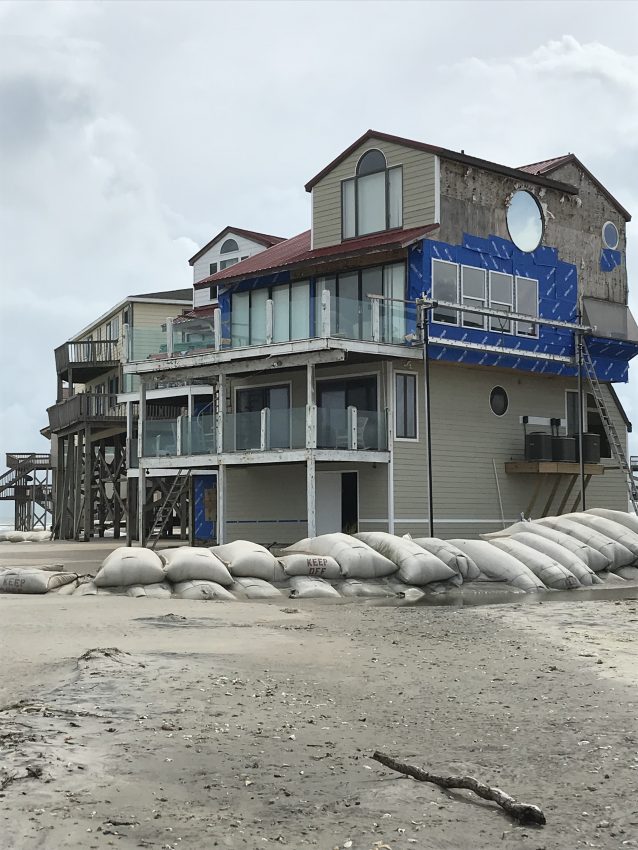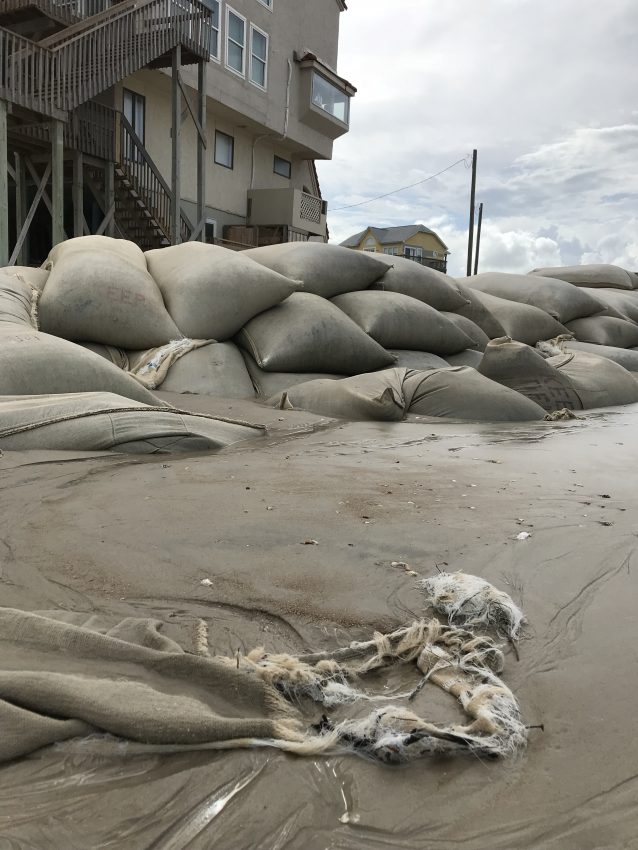

The issue
In 2011, the North Carolina General Assembly lifted a 30-year-old ban on hardened structures and passed a law allowing up to four “test” terminal groins to be built along the North Carolina coast. In 2015, legislators passed an additional bill allowing two more terminal groin projects to apply for the required permits. One such project is being planned by the Town of North Topsail Beach, who is considering proposals for a terminal groin to be built adjacent to New River Inlet.
Like many beach towns in North Carolina, the Town of North Topsail Beach has been struggling with erosion at the north end of the island for decades. The town’s channel-realignment project completed in early 2013 failed to curb erosion at the north end and a massive sandbag revetment is permitted through 2022 for much of the north end of the island.
Applied Technology and Management Inc. (ATM) has been hired by the town to explore options for construction of a terminal groin on the south side of New River Inlet. As presented to the Town in 2018, ATM recommends a 1,500-foot structure with permits to add an additional 500-foot anchor later if needed, similar to the two-phase groin project at Bald Head Island. ATM suggests that a groin would reduce erosion at the north end of Topsail Island and cut back the frequency of dredging in the New River Inlet.
Construction costs for the 1,500 structure (excluding any additional anchors) are estimated at $4.5 million. These costs cover only the cost of construction and do not include necessary beach stabilization measures.
Dial Cordy and Associates, Inc. has initiated development of a draft Environmental Impact Statement (EIS). An EIS describes the impacts a proposed project may have on the environment, and also describes project alternatives and any plans to mitigate the impacts. A draft EIS timeline has been submitted to the U.S. Army Corps of Engineers, but has not yet been made public.
The federation is actively following the proposed terminal groin at New River Inlet. We work to provide people and groups the assistance needed to take an active role in the stewardship of North Carolina’s coast, which belongs to us all. The federation works towards a sustainable barrier island estuarine system that can survive and flourish, especially in the face of more severe storms and sea level rise.
Should the terminal groin project move forward, property owners at North Topsail Beach will be left with a long-term financial burden in an effort to control erosion. Terminal groins can cause unintended consequences that harm the public beach, further erode downdrift of the inlet and potentially increase the risk and erosion in the central reach beach project and put other property owners at risk. It is key for all stakeholders and community members to work together to find a sustainable solution for a changing coastline.
What’s At Stake
Damage & erosion: A terminal groin may result in damage and erosion on adjacent islands and estuaries further down-drift from the groin.
Critical habitat: The proposed hardened structure along this natural beach and inlet system threatens to destroy critical habitat for fish, birds and sea turtles.
Public access & recreation: A terminal groin at New River Inlet would eliminate treasured public beach areas used by thousands of people every year for fishing, boating and swimming.
FAQs
What exactly is a terminal groin?
A terminal groin is a rock, concrete, stone or metal structure built on the side of an inlet at the end (terminus) of an island, perpendicular to the coast.
How does a groin work?
Groins trap some sand by blocking the current as it moves along the beach. Once about two or three hundred yards of sand is trapped, sand can move around the groin depending on the groin length, size and inlet geology. Groins do not prevent sand from entering inlets and channels, and are not designed to help with navigation.
Are groins and jetties the same?
No. Jetties are longer than groins and they are built for navigation purposes. Groins are built to try to keep a barrier island in place and to try to prevent erosion of beaches.
Will a terminal groin protect the island from hurricanes?
No. Groins are not meant to protect the island or the structures on it from hurricanes. In fact, they are as susceptible to hurricanes as any other structure on the island. They could cause unpredictable erosion damage because they can channel floodwaters in unnatural ways.
Resources
Coastal Hazards & Targeted Acquisitions: A Reasonable Shoreline Management Alternative
